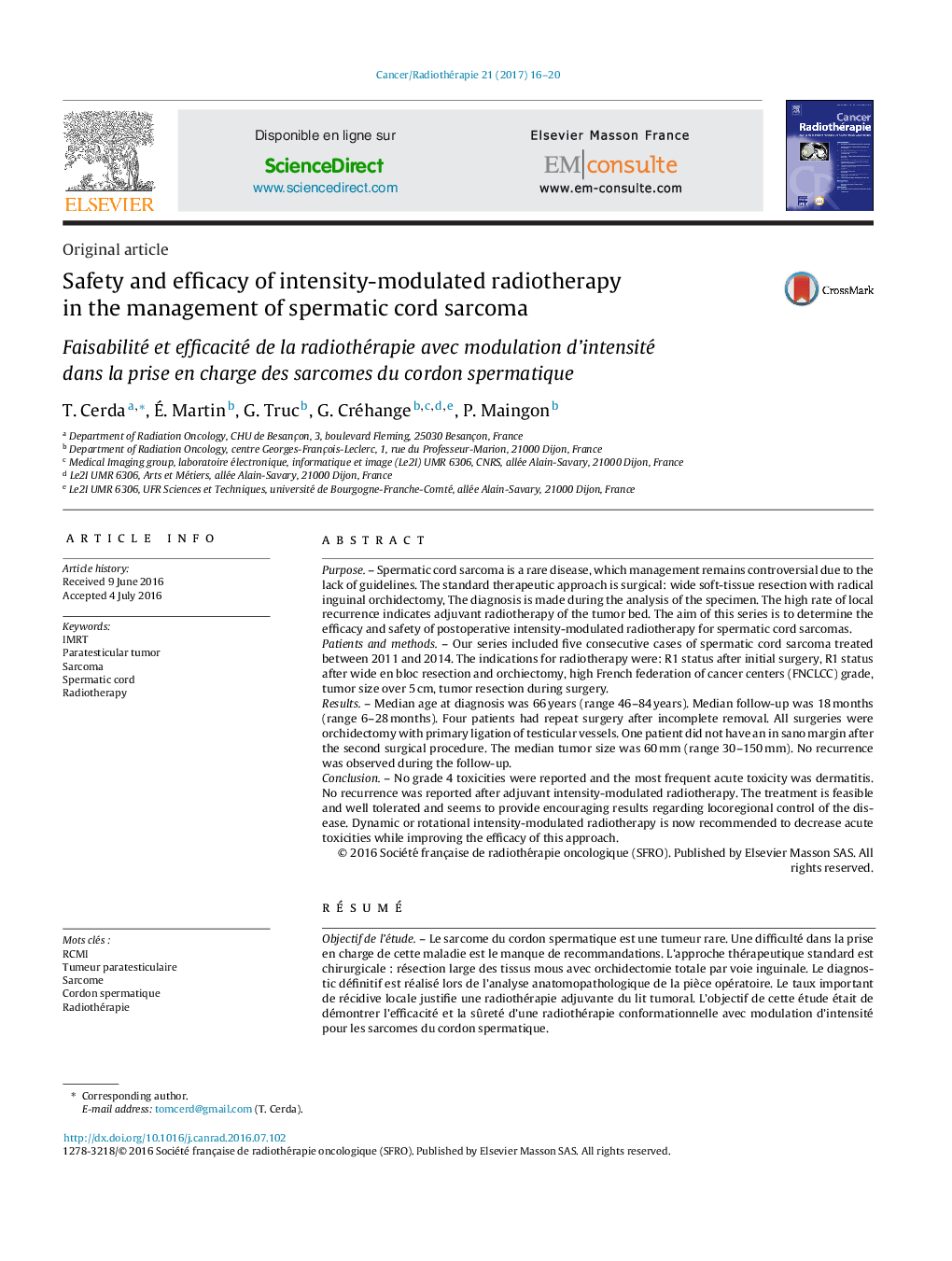| کد مقاله | کد نشریه | سال انتشار | مقاله انگلیسی | نسخه تمام متن |
|---|---|---|---|---|
| 5525939 | 1401507 | 2017 | 5 صفحه PDF | دانلود رایگان |

PurposeSpermatic cord sarcoma is a rare disease, which management remains controversial due to the lack of guidelines. The standard therapeutic approach is surgical: wide soft-tissue resection with radical inguinal orchidectomy, The diagnosis is made during the analysis of the specimen. The high rate of local recurrence indicates adjuvant radiotherapy of the tumor bed. The aim of this series is to determine the efficacy and safety of postoperative intensity-modulated radiotherapy for spermatic cord sarcomas.Patients and methodsOur series included five consecutive cases of spermatic cord sarcoma treated between 2011 and 2014. The indications for radiotherapy were: R1 status after initial surgery, R1 status after wide en bloc resection and orchiectomy, high French federation of cancer centers (FNCLCC) grade, tumor size over 5Â cm, tumor resection during surgery.ResultsMedian age at diagnosis was 66Â years (range 46-84Â years). Median follow-up was 18Â months (range 6-28Â months). Four patients had repeat surgery after incomplete removal. All surgeries were orchidectomy with primary ligation of testicular vessels. One patient did not have an in sano margin after the second surgical procedure. The median tumor size was 60Â mm (range 30-150Â mm). No recurrence was observed during the follow-up.ConclusionNo grade 4 toxicities were reported and the most frequent acute toxicity was dermatitis. No recurrence was reported after adjuvant intensity-modulated radiotherapy. The treatment is feasible and well tolerated and seems to provide encouraging results regarding locoregional control of the disease. Dynamic or rotational intensity-modulated radiotherapy is now recommended to decrease acute toxicities while improving the efficacy of this approach.
RésuméObjectif de l'étudeLe sarcome du cordon spermatique est une tumeur rare. Une difficulté dans la prise en charge de cette maladie est le manque de recommandations. L'approche thérapeutique standard est chirurgicale : résection large des tissus mous avec orchidectomie totale par voie inguinale. Le diagnostic définitif est réalisé lors de l'analyse anatomopathologique de la pièce opératoire. Le taux important de récidive locale justifie une radiothérapie adjuvante du lit tumoral. L'objectif de cette étude était de démontrer l'efficacité et la sûreté d'une radiothérapie conformationnelle avec modulation d'intensité pour les sarcomes du cordon spermatique.Patients et méthodesNotre série de cas est composée de cinq cas consécutifs de sarcome du cordon spermatique traités entre 2011 et 2014. Les indications de radiothérapie adjuvante étaient : statut R1 après chirurgie initiale, statut R1 après résection large monobloc et orchidectomie, haut grade selon la Fédération nationale des centres de lutte contre le cancer (FNCLCC), taille tumorale de plus de 5 cm.RésultatsL'âge médian au moment du diagnostic était de 66 ans (46-84 ans). La durée de suivi médian était de 18 mois (6-28 mois). Quatre patients ont eu une chirurgie de rattrapage après résection incomplète. Tous les patients ont eu une orchidectomie totale avec ligature première des vaisseaux testiculaires. La taille tumorale médiane était de 60 mm (30-150 mm). Aucune récidive n'a été observée pendant la durée du suivi.ConclusionAucun effet secondaire de grade 4 n'a été observé et la toxicité la plus fréquente était cutanée. Aucune récidive n'a été observée après radiothérapie conformationnelle avec modulation d'intensité adjuvante. Le traitement est faisable et bien toléré et semble fournir des résultats encourageants en termes de contrôle locorégional de la maladie. La radiothérapie conformationnelle avec modulation d'intensité dynamique ou rotationnelle est maintenant indiquée pour réduire la toxicité aiguë tout en améliorant l'efficacité de cette stratégie.
Journal: Cancer/Radiothérapie - Volume 21, Issue 1, February 2017, Pages 16-20